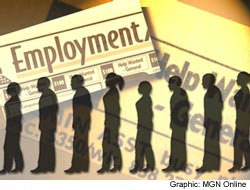WASHINGTON (FinalCall.com) – With Labor Department statistics showing unemployment insurance claims rising to over 4.6 million, still more face unemployment resulting from budget cuts as many state governments face financial resource gaps of tens of billions of dollars in FY 2009 and FY 2010.

Matthew Sherman, Research Assistant at the Center for Economic and Policy Research writes in an issue brief, “The Effect of Budget Belt-Tightening on Employment,” that in a worst case scenario–in which state governments address their budget shortfalls with only spending cuts–budget belt-tightening would lead to losses of over 350,000 jobs in FY 2009 and almost 900,000 jobs in FY 2010.
“Spending cuts have the effect of restricting demand and increasing unemployment. During a recession, when the economy is already shrinking, these ‘pro-cyclical’ measures can make things worse,” said Mr. Sherman.
According to the report, thirty-eight states plus the District of Columbia are facing budget gaps totaling $30 billion this year, and twenty-six states are projecting shortfalls in their budgets for the fiscal year 2010 of over $60 billion.
New York’s budget gap next year is expected to be eight times larger than the shortfall this year, growing from $1.5 billion to $12.5 billion. California, already facing an $8.4 billion deficit, is projecting a $19.5 billion shortfall next year.
As state and local governments are forbidden by law or tradition to run budget deficits, they are limited in the methods they can use to remedy their budget gaps.
Philadelphia Governor Edward G. Rendell announced a plan to address that state’s General Fund shortfall that is projected for the remainder of the 2008-09 fiscal year.
“Based on revenue collections through November and current economic forecasts, we are projecting that revenues at the end of the current fiscal year will be below estimate by $1.6 billion,” Gov. Rendell said at an unprecedented public briefing at the mid-point of the state’s fiscal year.
“We need to take steps now to adjust our budget while preserving programs that will help speed our economic recovery and that provide a safety net to vulnerable Pennsylvanians during this difficult time,” Gov. Rendell added.
Gov. Rendell is proposing to close the projected $1.6 billion deficit without any new taxes. The plan includes wage freezes, the elimination of cost of living adjustments, a hiring freeze and ending out of state travel.
“I know the adjustments we have announced will be difficult for many Pennsylvanians. Tough choices and decisions have had to be made, but tougher ones may be on the horizon,” Gov. Rendell said.
The rising unemployment numbers are predicted to continue in 2009.
When the November employment report came out December 5, 2008, Chief Economist Chad Stone at the Center on Budget and Policy Priorities explained that the report makes it more likely that unemployment will reach 9 percent by the end of 2009, as Goldman Sachs has predicted.
“The Center on Budget and Policy Priorities estimates this could swell the number of Americans living in poverty by up to 10 million and the number of Americans in deep poverty, with incomes below half the poverty line, by up to 6 million,” he said.
Overall labor market trends are grim.
Private and government payrolls combined have shrunk for 11 straight months, and net job losses so far this year total 1.9 million. (Private sector payrolls, which began shrinking in December 2007, have seen a cumulative loss of 2.1 million jobs over the past 12 months.)
Almost two-thirds (533,000) of the payroll job losses occurred in November 2008. 320,000 occurred in October, and 403,000 in October-320,000 in September. The official unemployment rate, which was 5 percent at the start of the recession last December, reached 6.7 percent in November, and other indicators show even greater labor market weakness.
The percentage of the population with a job (61.4 percent) has fallen to its lowest level since 1993. More than one-fifth (21.4 percent) of the 10.3 million unemployed have not been able to find a job despite looking for 27 weeks or more.












